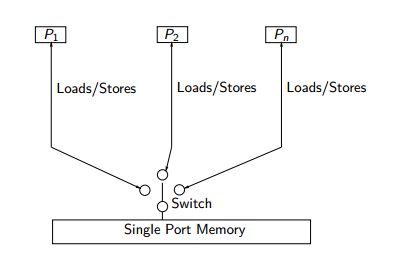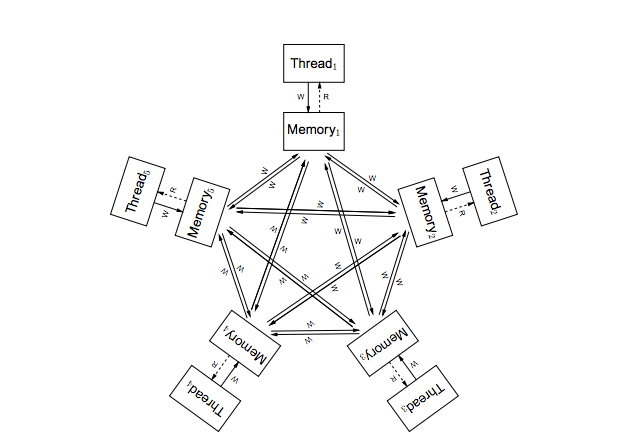CSC/ECE 506 Spring 2013/10b ps: Difference between revisions
No edit summary |
No edit summary |
||
| Line 25: | Line 25: | ||
==Mobile Devices== | ==Mobile Devices== | ||
[[File:ARM_Star.png|center|frame||Conceptual | [[File:ARM_Star.png|center|frame||Conceptual ARM architecture]] | ||
[[File:ARM_tree.png|center|frame||ARM Thread level execution]] | |||
==Is There an in Between (Personal Business Class PC architectures)== | ==Is There an in Between (Personal Business Class PC architectures)== | ||
==Are These All Related (What is common and what is not between them)== | ==Are These All Related (What is common and what is not between them)== | ||
Revision as of 11:37, 3 April 2013
Topic_Writeup
Past Wiki 1
Past Wiki 2
Introduction
In this wiki we seek to perform a survey of memory consistency models in modern microprocessors. We will begin by giving a brief synopsis of what memory consistency is and how it can be achieved. We will also discuss some legacy systems that utilized some initial consistency models and then discuss how those models evolved into more sophisticated versions in more recent years. After we have this foundation we will move into more advanced architectures and implementations typically seen today. This will include an investigation on what conditions certain memory models are used more often as opposed to others. We will complete our discussion by taking a look at the direction memory models are expected to take in the near future.
What is Memory Consistency
In order for our discussion to begin we must understand what a Memory Consistency Model is. The Memory Consistency Model specifies how memory behaves when multiple processors do reads and writes to the same location. Because this concept has such a vast scope for such a critical role to the system, memory consistency impacts system design, programming languages, and underlying hardware.
This is critically important because we want our systems to be as efficient as possible. In order to achieve this goal there are various optimizations the system performs to overlap operations and allow these operations to complete out-of-order. To add to this challenge, there are also several optimizations the compiler can perform to increase execution efficiency. It is intuitive to think that instructions are executed sequentially but in reality this execution really only needs to be sequential where operations operate on the same memory location. As multi-processor systems and parallel computing became more of a necessity in the technology industry the necessity for correct and highly efficient memory consistency models came into place. Memory consistency allows for techniques to optimize execution but also puts a contract in place to ensure correctness between the programmer and the system. In short, allowing tasks to execute in parallel is great for improving performance, but it also introduces new challenges because these tasks can now complete in different order than how they were initially conceived [16, 10].
How Memory Consistency Used to be Done
It is intuitive to think of operations executing on a multi-processor system to behave the same as instructions executing on a single processor system. This an interleaving model called Sequential Consistency and is the classical approach to consistency can be achieved. It was formally defined by Lamport as, “The result of any execution is the same as if the operations of all the processors were executed in some sequential order, and the operations of each individual processor appear in this sequence in the order specified by its program.” What this means is that all memory access are immediately visible to all processors.

This type of system was seen in the 1980’s and present in system like the 386-based Compaq SystemPro. The key way Sequential Consistency was able to achieve overlap was to put writes in a write buffer so that the computation can be overlapped to the next read. Memory operations are issued in program order by processors. Because operations are executed one at a time they appear to be atomic with respect to each other.
The advantages to a model like this is that it is easy to understand from a programmer perspective. Unfortunately the rules put in place by this model are very restrictive and can negatively impact performance. Sequential Consistency disallows the reordering of shared memory operations between processors. The drawbacks of this strict model produces high latency and very little benefit of true serial execution. This is because reads tend to be closely interleaved with writes yielding very little utilization of the write buffer.
How Has Memory Consistency Evolved
Implementations
High Powered Machines
Mobile Devices


Is There an in Between (Personal Business Class PC architectures)
Are These All Related (What is common and what is not between them)
Where Do We Go From Here
References
1. http://www.intel.com/content/www/us/en/architecture-and-technology/64-ia-32-architectures-software-developer-vol-3a-part-1-manual.html
2. http://pic.dhe.ibm.com/infocenter/lnxinfo/v3r0m0/topic/liaaw/ordering.2006.03.13a.pdf
3. http://dl.acm.org/citation.cfm?id=1941553.1941594
4. http://home.deib.polimi.it/speziale/tech/memory_consistency/mc.html
5. http://homes.cs.washington.edu/~djg/papers/asf_micro2010.pdf
6. http://people.ee.duke.edu/~sorin/papers/asplos10_consistency.pdf
7. http://www.rdrop.com/users/paulmck/scalability/paper/whymb.2010.06.07c.pdf
8. http://en.wikipedia.org/wiki/Memory_ordering
9. http://www.montefiore.ulg.ac.be/~pw/cours/psfiles/struct-cours12-e.pdf
10. http://www2.engr.arizona.edu/~ece569a/Readings/ppt/memory.ppt
11. http://ipdps.cc.gatech.edu/2000/fmppta/18000989.pdf
12. http://preshing.com/20120930/weak-vs-strong-memory-models
13. http://csg.csail.mit.edu/pubs/memos/Memo-493/memo-493.pdf
14. http://classes.soe.ucsc.edu/cmpe221/Spring05/papers/29multi.pdf
15. http://os.inf.tu-dresden.de/Studium/DOS/SS2009/04-Coherency.pdf
16. http://infolab.stanford.edu/pub/cstr/reports/csl/tr/95/685/CSL-TR-95-685.pdf
17. http://www.cl.cam.ac.uk/~pes20/ppc-supplemental/test7.pdf
18. http://www.cl.cam.ac.uk/~pes20/ppc-supplemental/pldi105-sarkar.pdf
19. http://www.cs.utah.edu/formal_verification/publications/conferences/pdf/charme03.pdf
20. http://www.cl.cam.ac.uk/~pes20/weakmemory/x86tso-paper.tphols.pdf